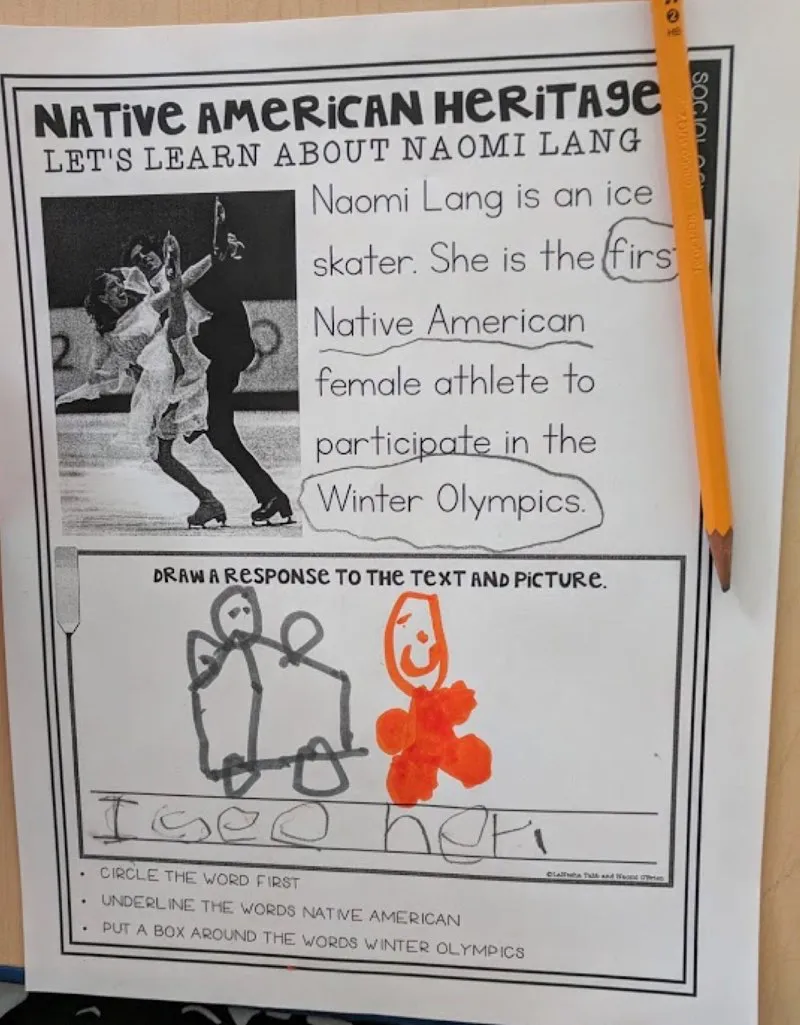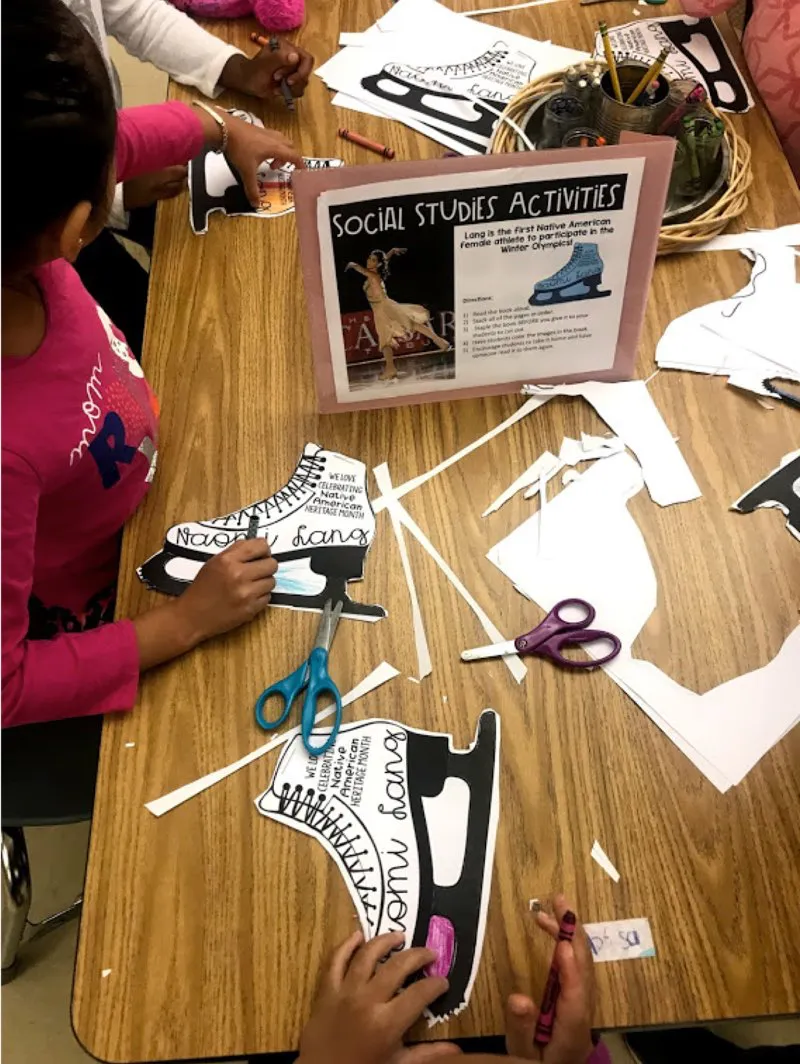Revamping social studies in our classrooms, especially creating a huge focus on appreciating culture, was the shift we never knew we needed. We called it our love letter to students. We set out to heal, enlighten, and promote curiosity about our world, and that’s exactly what we did.
We taught our first self-created social studies lesson in January of 2017. We were building the car as we drove it down the road. When we first began this work, we found that almost every month of our traditional school year had a nationally recognized heritage month assigned to it: February is Black History Month, March is Women’s History Month and Irish American Heritage Month, May is Asian and Pacific American Heritage Month, October is Italian American Heritage Month . . . The list goes on and on. This was a great starting point to help us map out what studying culture in the classroom could look like. However, we do not subscribe to the idea that certain cultures should exclusively be covered during a particular month. This is an example of what we meant when we said that our learning is always evolving. At first, celebrating a culture during its month sounded great. We quickly realized why that isn’t the best idea—that’s just where our thinking was years ago when we began this work. We now believe in creating a learning environment where a variety of cultures are always recognized and celebrated year-round.
Working across the country from each other, we began to build monthly social studies units for classes of students in kindergarten through third grade. We knew that once we had piloted these ideas in our own classrooms, we were going to share them with everyone else.
We were initially worried that our students would be terribly bored learning about history and culture, but we quickly realized that it actually brought them to life. They craved learning about real people from real places dealing with real things. Students who were usually reluctant to join in on a conversation suddenly had so much to say, ideas to share, and questions to ask. When we taught about the contributions and struggles of Irish American men and women, our kindergarten students were shocked to learn about the discrimination they faced, and the kids had many opinions about what they would have done in their shoes.

Topics covered when we taught culture during a month vs. incorporating these topics year-round
As each new month approached, we searched high and low for new stories to tell, a culture to highlight, a rarely considered perspective to present, and a different part of the map to explore. We wanted to make sure we weren’t just giving our kids more pumpkins (eventually we did create a pumpkin unit, but more about that later).
When the time came for us to dive into Native American Heritage Month, our students were surprised to discover a number of things: First, after watching a series of interviews online, we learned that not all Indigenous people feel that they should be called Indians. The videos explained that Columbus called the First Nations people that he encountered “Indians” because he thought he had crossed the Indian Ocean. Some students were even surprised that there are still Native Americans living today. Students expressed that the only time they ever saw Indigenous people was in the past, typically in images where they were contributing to Thanksgiving dinner with the Pilgrims or fighting cowboys. In fact, they were surprised to learn that there are millions of Indigenous people in the US today. We spent some time in disbelief at this, but then we had to consider that when children aren’t exposed to various cultures or people and they are left to fill in the gaps—through books, television, or other forms of media where representation is often nonexistent or stereotypical—it’s not surprising that misconceptions like this arise. We listened as Indigenous people shared feelings about some of those hurtful stereotypes circulating about Native Americans. We taught our students that all Native tribes or nations are not exactly the same. They are unique and can have their own customs, traditions, languages, and more.
We also learned about a woman named Naomi Lang. She was the first Native American woman to compete in any Winter Olympics Games. She is an ice skater and also a member of the Karuk tribe, one of the largest tribes in California. We found some videos of her competing in the Winter Olympics on YouTube, and our kindergarten and first grade students were mesmerized. Some were introduced to ice dancing and skating for the first time, which gave them a new idea about what they could be when they grew up.


When they learned about how children in South Korea honor their parents for Parents’ Day, our students quickly made the connection between Parents’ Day and Mother’s Day and Father’s Day in the United States. They made a connection to a country on the other side of the world. “Where is South Korea?” “Can we take a field trip there?” “Can we drive there?” “What do they eat there?” “Do they speak Chinese there?” The questions, conversations, and misconceptions that consistently came up during our lessons all amounted to the same things: student engagement and authentic learning.
Students were intrigued and begged to know more. We were often late to lunch because we were taking a “trip” via Google Maps to the country we were learning about that day, looking up a question about a culture that we didn’t know the answer to, or sharing our comments about a new topic. Our kindergarten and first grade students had debates and discussions; they shared and defended their opinions while respectfully listening to others.
These culture lessons also provided a chance to learn about some amazing and notable people. When we studied Irish American heritage, we learned about the Sullivan brothers, five brothers who all lost their lives in battle, leading to the Sole Survivor policy. We cleared up the misconception that Alexander Bell invented the telephone, which persists even though in 2002 Congress recognized Antonio Meucci as the actual inventor. Meucci was a poor Italian immigrant who reportedly lacked the twenty dollars that he needed to secure the patent. Meucci even took Bell to court, but he would never gain his due credit.
We also learned about a man named Ettore Boiardi (you might know him as Chef Boyardee) who came to the United States through Ellis Island. He worked in a kitchen but eventually was involved in catering the wedding of a United States president. As we read and talked about him, students noticed the changing of his last name. “Why did he change the way he writes his name? It looks different,” a student remarked. We had a lot of conversations about cultural erasure and assimilation, and we talked about how a lot of people were forced (and some actually chose) to have their names simplified in order to blend in. A student commented, “We should send a text message to Ettore Boiardi and tell him to spell his name correctly because we could learn how to say it right!” We love the hearts of young children.
The two of us teachers would talk each night in awe of the connections our students had made and the conversations we were able to facilitate. We were seeing that not only can little kids have big conversations, they have important ideas to contribute and the power to use those mindsets to change the world. We still firmly believe that.
LaNesha:It was February, and we had just completed our Black History unit. In my class, we do tons of heavy learning during Black History Month. I’m talking history, culture, celebrating notable figures—the works!The area that I teach in has many different cultural backgrounds represented. As we were wrapping up the unit, our room covered in beautiful Black history images, one of my Latina students walked over to me and said, “Mrs. Tabb, this was AWESOME! When are we going to learn about my culture?” Gulp. At that point, it honestly had not occurred to me to explicitly teach any other cultures.Growing up, we rarely studied culture, and if we did, it was typically during Black History Month. I replayed her words in my head for the next few days. I decided to do a little research—because if I was going to highlight another culture with the same energy that I had just given in February, I would need to learn more. I hopped online to Pinterest, blogs, and websites where teachers can purchase resources created by other teachers. On one site, I typed in “Black history” and filtered the results to only show resources for kindergarten through second grade. I found roughly ten thousand results—and I was pretty satisfied with that number.I got a little more curious and swapped out Black history for Hispanic and Latinx history. Now there were only about two hundred and thirty results to pick from, and most of them were along the lines of “Cinco de Mayo bingo.” That certainly wasn’t going to work if I truly wanted to provide my students with an authentic experience. I kept going. Asian American heritage . . . down to fifty-four results. Native American heritage: thirty-nine units, and most of those centered around things like “Build a teepee STEM challenge.” That’s when it hit me. Something needed to be done.
When the next school year came around, we had many conversations about what a kickoff to social studies for August would look like. The first thing we wanted to do to was make sure that our students had a solid understanding of our social studies subtopics. We created anchor charts with plenty of photo support so that students would be able to connect with each topic. ...

